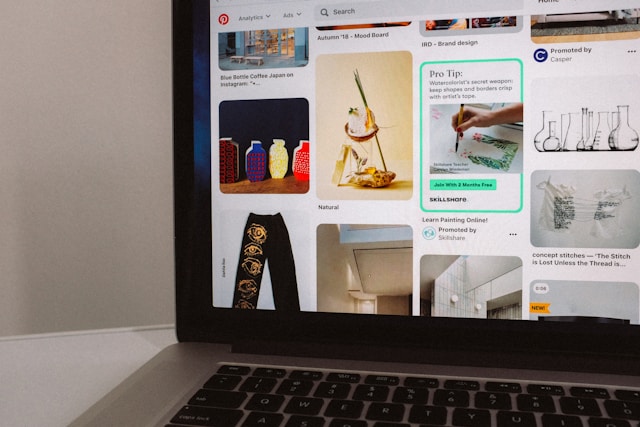Pinterest for eCommerce: How to Turn Pins into Profits. I’ll admit it—I used to think Pinterest was just a rabbit hole of banana bread recipes and wedding decor ideas. But oh boy, was I wrong. What started as a platform full of DIY dreams and aesthetic inspo has quietly grown into a sales-generating powerhouse for eCommerce businesses. If you’re running an online store and haven’t tapped into Pinterest yet, you’re missing out on a goldmine of opportunity.
So grab your favorite cup of coffee (or herbal tea, no judgment), and let’s dive into how Pinterest can take your eCommerce hustle to the next level.
Why Pinterest Is the Unsung Hero of eCommerce
Let’s get one thing straight: Pinterest isn’t your typical social media platform. It’s more like a visual search engine, where people go to plan—not just to scroll. And planning usually leads to purchasing.
Think about it. Pinterest users search for things like “home office setup,” “summer outfit ideas,” or “gifts for dog lovers.” That’s not just casual browsing. That’s intent. And where there’s intent, there’s money on the table.
The kicker? Your pins can keep bringing in traffic months after you post them. Unlike Instagram or TikTok where posts disappear into the void after 24 hours, pins live forever—like digital seeds that grow over time.

Pinterest for eCommerce
First Things First: Set Up a Pinterest Business Account
You don’t need to be tech-savvy to get started. Just create a Pinterest Business Account (or convert your personal one), verify your website, and boom—you unlock juicy features like analytics, ads, and rich pins.
Rich pins are like product pins on steroids. They automatically pull info like price and availability from your site and update it in real-time. That means less manual work and more accurate listings. Win-win!
Pro tip: Use Pinterest’s own Rich Pins Validator to make sure everything’s connected properly.
Creating Pins That Pop (and Convert)
Pinterest is all about aesthetics. If your pin doesn’t stop the scroll, it’s toast.
Here’s what works:
-
Vertical format (2:3 ratio) – Tall pins = more screen space.
-
Text overlays – Add short, bold titles like “10 Cozy Winter Outfits” or “The Best Skincare Kit for Oily Skin.”
-
Consistent branding – Use your brand colors, fonts, and logo to stay memorable.
-
Clean product images – Lifestyle shots > white backgrounds. Show your product in action.
Don’t have design chops? Canva’s got your back. They’ve got pre-made Pinterest templates that’ll make your pins look like you hired a designer.
Use Keywords Like a Pro (Yes, Pinterest Has SEO)
Pinterest isn’t just pretty—it’s smart. Like Google, it relies on keywords to serve up relevant content. So if you’re selling handmade soy candles, you’ll want to sprinkle keywords like “non-toxic candles,” “gift for her,” or “cozy home scent” throughout your:
-
Profile name and bio
-
Board titles and descriptions
-
Pin titles and descriptions
Bonus: Use Pinterest’s search bar to find what people are actively looking for. Just start typing and let autocomplete show you the magic..
Pinterest for eCommerce
Organize Your Boards for Browsing Bliss
Boards are more than digital folders—they’re shop windows.
Instead of dumping all your products into one “Products” board (yawn), get specific. Try:
-
“Eco-Friendly Gift Ideas”
-
“Boho Home Decor”
-
“Self-Care Essentials for Busy Moms”
You can even mix in lifestyle pins or content from others to keep things fresh. Pinterest rewards value, not just self-promotion.
Grow Your Audience (Without Spending a Dime)
Consistency is key. Pin daily if you can—even just 5 to 10 pins. Tools like Tailwind let you schedule pins ahead of time so you’re not chained to your screen.
Other growth hacks:
-
Join group boards in your niche
-
Repin from others (not just your own stuff)
-
Engage with Pinterest communities or comment on trending pins
Think of it like networking, but in yoga pants.
Track What’s Working with Pinterest Analytics
Once your pins are out in the wild, check your analytics regularly. Look at:
-
Impressions – Are people seeing your pins?
-
Saves – Are they bookmarking them for later?
-
Outbound clicks – Are they clicking through to your shop?
Got a pin that’s popping off? Make more like it. Got one that flopped? Rework the design or test a new keyword.
Final Thoughts: Pin It to Win It
Pinterest might not be the flashiest platform out there, but it works like a charm—especially for product-based businesses. It’s slow burn marketing that pays off over time, like compound interest for your store.
So stop sleeping on Pinterest. Create your business account, pin your prettiest products, optimize those keywords, and let the algorithm do its thing.
Happy pinning!


